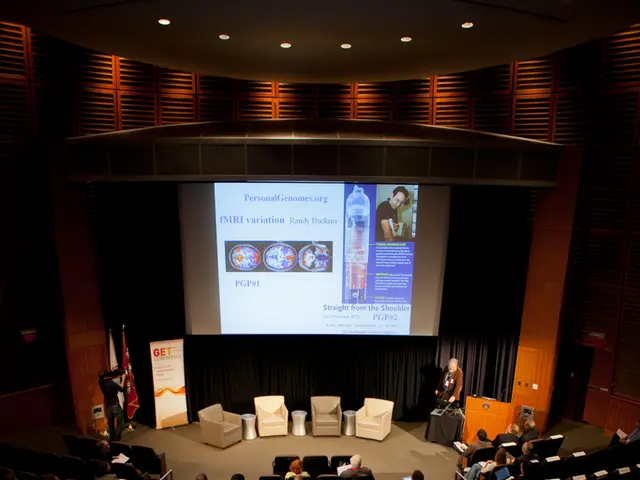Navigating chaotic circumstances: Explore the concept of "tactical retreat"
In today's challenging economic landscape, characterized by volatile geopolitical environments and AI advancements, business leaders often turn to "subtractive" tactics to improve efficiency. However, it's crucial to remember that blindly chopping away at resources for the sake of efficiency can lead to short-term gains and long-term pitfalls. Instead, let's discuss strategic subtraction - a method that helps you innovate, positioning your organization for resilience, even during disruptions.
Strategic subtraction involves evaluating subtractive measures with respect to three key performance objectives: efficiency, resilience, and prominence. A successful implementation of this approach ensures that your business doesn't trade long-term value for immediate gains.
- Efficiency: Streamline your operations, save resources, and time.
- Resilience: Adapt to inconveniences, maintain essential functions amidst turbulence.
- Prominence: Bolster your visibility and appeal to stakeholders, keeping them engaged.
Subtractive actions that fail this triple test could transform a short-term triumph into a catastrophic liability down the line. To ace the triple test, here are six fundamental subtractive transformations that can help you balance efficiency, resilience, and prominence.
- Purge: Scrap unneeded components, steps, or choices for a leaner, meaner machine.
- Swap: Replace complicated components with sleeker alternatives to create a more elegant solution.
- Camouflage: Minimize user complexity while keeping the essentials accessible for a happier, stress-free experience.
- Pause: Suspend functions during quiet times or when not needed and resume them when conditions change.
- ** abstract**: Create intuitive interfaces that handle the complexities in the background, providing an effortless experience.
- Integrate: Amalgamate multiple functions, components, or points of contact into unified systems, performing the same function with fewer parts.
By making subtraction a predefined strategy, you develop an important core capability that helps teams plan, prioritize, and innovate in a turbulent climate. Here's how to make that happen:
- Embed subtraction in your processes: Subtraction should be integrated as part of the broader shift towards "doing more with less."
- Introduce subtractive design challenges: Align challenges with focusing on essential value, not adding new features.
- Recognize and celebrate subtraction: Reward teams for identifying and eliminating unnecessary work, emphasizing the value of simplification.
Finally, Generative AI can also support subtractive transformation by discovering opportunities that might go unnoticed by humans. For instance, using AI, a major medical care provider in India could:
- Elimination: Replace in-person follow-up consultations with teleconsultations for stable chronic conditions, enhancing patient comfort, ensuring care continuity, and signifying innovation leadership.
- Substitution: substitute traditional paper-based admissions with voice-activated digital forms, reducing input errors, improving record accuracy, and demonstrating innovation leadership.
- Consolidation: Integrate all patient touchpoints (appointments, reports, payments, pre-evaluations) into a single mobile application to optimize their experience, centralize communication, and demonstrate digital accessibility.
- Hiding: Implement intelligent triage systems that hide complexity, improving patient satisfaction and sustaining care quality.
- Pause: Introduce a flexible appointment scheduling system that allows patients to pause and reschedule without penalty, reducing no-shows and maintaining care relationships.
- Abstraction: Develop a unified patient portal that abstracts all health interactions behind a single interface, simplifying access, sustaining service continuity, and further emphasizing innovation.
So, rather than joining the frenzy of adding more features and costs, focus on the value of subtraction. Strategic subtraction is the real differentiator in an era where everyone is busy piling it on.
- In the realm of finance, focus on streamlining operations for savings in resources and time.
- For the entrepreneur, consider implementing resilient strategies to adapt to economic turbulence.
- In the world of interior-design, minimize user complexity for a happier, stress-free experience.
- In the art of cooking, pause specific processes during quiet periods or when not necessary.
- For an entrepreneur aiming to lead with grace, camouflage complexities behind intuitive interfaces.
- To make family-dynamics run smoothly, integrate multiple aspects into unified systems for streamlined cohesion.
- To manage a small-business effectively, purge unnecessary components for a leaner, more efficient operation.
- When it comes to investing, swap complicated components with sleeker alternatives for a more efficient portfolio.
- In the realm of wealth-management, consolidate all touchpoints into a single platform for ease of access.
- In home-and-garden, reduce resources by using the camouflage approach to minimize waste and maintain functionality.
- When it comes to home-improvement, abstraction is key, managing complexities in the background for a seamless experience.
- For a baker seeking efficiency in their business, integrate multiple processes into unified systems for a more streamlined approach.
- To manage your love-and-dating life, pause certain actions during quiet times or when not necessary for better efficiency.
- In the business world, practice purge to eliminate ineffective strategies and make room for growth.
- In your careers, replace traditional methods with simpler, more modern alternatives to increase productivity.
- To secure venture-capital, demonstrate innovative leadership by implementing efficient, resilient solutions.
- In personal-finance, consider consolidating all financial touchpoints into a single platform for centralized management.
- When it comes to creating recipes for global-cuisines, abstract the complexities for effortless cooking experiences.
- To manage real-estate investments wisely, incorporate intelligent triage systems for improved efficiency.
- In the stock-market, pause certain investments during unstable periods to minimize losses and maintain resilience.
- To manage your debt, integration is key, consolidating multiple debts into a single, manageable plan.
- In data-and-cloud-computing, eliminate unneeded components for a leaner, meaner machine.
- In gardening, consider swapping complex plants with sleeker, lower-maintenance alternatives for a more elegant aesthetic.
- To promote sustainable-living, abstract complexities in everyday habits to make green choices easier.
- When it comes to budgeting, pause unnecessary expenses during quiet periods for savings.
- In a technology landscape, practice abstraction to manage complexities and improve user experience.
- To embrace artificial-intelligence, implement subtraction through intelligent triage systems for improved efficiency.
- When it comes to healthy cooking, camouflage complexities behind intuitive methods for a stress-free experience.








